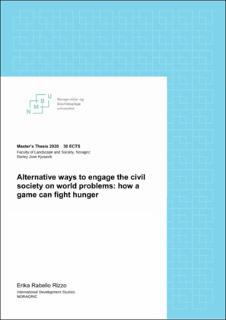| dc.contributor.advisor | Kjosavik, Darley Jose | |
| dc.contributor.author | Rabello Rizzo, Erika | |
| dc.date.accessioned | 2021-01-16T21:43:30Z | |
| dc.date.available | 2021-01-16T21:43:30Z | |
| dc.date.issued | 2020 | |
| dc.identifier.uri | https://hdl.handle.net/11250/2723337 | |
| dc.description.abstract | The game industry is one of the leading ones in the entertainment business. Its ability to engage people reach thousands of millions accross the world, is a great phenomenon. The expansion of the industry and its engagement levels signal that games can be used for other purposes than entertainment. Hence, this research explores how games can be used as an alternative solution to engage people in solving real world problems.
The focus of this study is on a specific case: the Free Rice game. Its purpose is to fight world hunger through a game interface which allows people to make free donations while playing. To analyse and understand the case, the research investigates whatthe players’ experiences are and how they feel while playing Free Rice. To fully comprehend the case, theories from both sides are presented: game design theory and food security, hunger, poverty and structural vioence theories.
This is a qualitative methods research based on a case analysis. To collect the data, the study used an online structured survey with open ended questions to understand the players’ experience on playing Free Rice. The research collected data from 23 different respondants that voluntarely play Free Rice. A mix of purposive and convinience sampling method was used to sort the participants. Purposive was necessary as the research aimed to analyze replies from a wide reange of countries as the game is played world-wide. Convinience was also used because the target group was not easily reachable as Free Rice does not offer a discussion forum in which the survey could be spread out.
The findings showed that Free Rice is mostly attractive to the participants because it offers the possibility to make free donations. The game seems to be challenging to most of the participants and it provides a learning outcome to all – mainly related to the language learning section. Overall, the players interviewed felt like their virtual efforts in the game were important in the bigger picture in the fight against hunger. | en_US |
| dc.language.iso | eng | en_US |
| dc.publisher | Norwegian University of Life Sciences, Ås | en_US |
| dc.rights | Attribution-NonCommercial-NoDerivatives 4.0 Internasjonal | * |
| dc.rights.uri | http://creativecommons.org/licenses/by-nc-nd/4.0/deed.no | * |
| dc.subject | Food security | en_US |
| dc.subject | Hunger | en_US |
| dc.subject | Alternative solutions | en_US |
| dc.title | Alternative ways to engage the civil society on world problems : how a game can fight hunger | en_US |
| dc.type | Master thesis | en_US |
| dc.description.version | submittedVersion | en_US |
| dc.subject.nsi | VDP::Humanities: 000 | en_US |
| dc.source.pagenumber | 78 | en_US |
| dc.description.localcode | M-DS | en_US |

